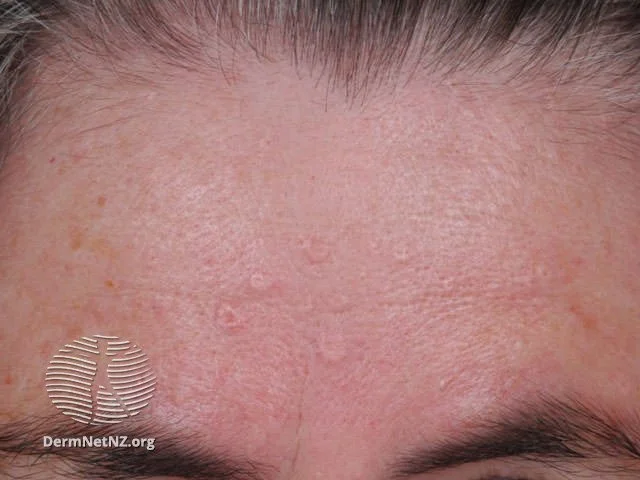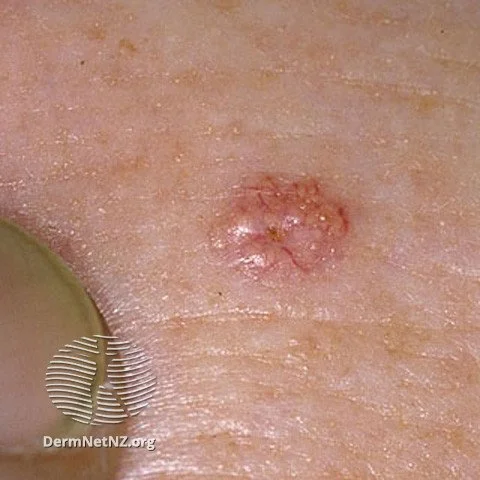
Sebaceous Hyperplasia
Sebaceous hyperplasia on the forehead can look like pimple-type bumps that don't go away.
Credit: DermNet NZ
What is sebaceous hyperplasia?
Sebaceous hyperplasia is a common, benign skin condition characterized by enlarged sebaceous glands, presenting as small, soft, yellowish, dome-shaped bumps on the skin. These bumps often have a central indentation. They typically appear on the forehead, cheeks, and nose, areas with a high concentration of oil glands.
What causes sebaceous hyperplasia?
The exact cause of sebaceous hyperplasia is not entirely clear, but several factors are believed to play a role:
Aging: As the skin ages, the sebaceous glands can enlarge, leading to the appearance of these bumps.
Genetics: Some individuals may have a genetic predisposition.
Hormonal factors: Changes in hormone levels might influence the sebaceous glands.
Ultraviolet (UV) radiation: Chronic sun exposure might contribute to the condition.
Certain medications: Immunosuppressant drugs, especially cyclosporine, have been linked to sebaceous hyperplasia.
What are the symptoms of sebaceous hyperplasia?
Sebaceous hyperplasia manifests primarily as skin lesions:
Appearance: Soft, yellowish papules with a central indentation
Size: Typically 2-5 mm in diameter
Texture: Smooth or slightly pebbly
Location: Mostly on the forehead, cheeks, and nose
Painless: The lesions are benign and don't cause any pain or discomfort.
How do I treat sebaceous hyperplasia?
While sebaceous hyperplasia is harmless and treatment isn't medically necessary, some people opt for removal due to cosmetic concerns:
Cryotherapy: Freezing the lesions using liquid nitrogen
Electrocautery: Using an electric current to burn off the bumps
Laser therapy: Certain types of lasers can effectively treat the condition
Photodynamic therapy (PDT): Combining light treatment with a photosensitizing agent
Topical treatments: Some retinoids can be effective, though results vary
Surgical excision: Removal of the lesion with a scalpel, primarily for larger lesions
How do I prevent sebaceous hyperplasia?
While you can't prevent sebaceous hyperplasia entirely, some steps might reduce the risk:
Sun protection: Regular use of sunscreen and sun-protective clothing
Skincare routine: Using products that don't clog pores and are non-comedogenic
Regular dermatological check-ups: Especially if you have a family history or other risk factors
Sebaceous hyperplasia sometimes can resemble basal cell carcinoma.
Credit: DermNet NZ
Sebaceous hyperplasia can slowly enlarge over time if they are not treated.
Credit: DermNet NZ



